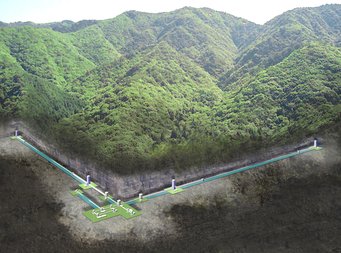GEO600 and KAGRA observe together
Results from joint Japanese-German gravitational-wave observing run
Right after the third observing run of the international gravitational-wave detector network ended in March 2020, the Japanese KAGRA and the German-British GEO600 detector made an extra lap. They continued simultaneously taking data for two weeks in a joint observing run. KAGRA is the latest addition to the growing worldwide scientific collaboration, constructed underground with novel technologies. Results from the joint run were published in “Progress of Theoretical and Experimental Physics” (PTEP).

“The KAGRA Collaboration is proud that, within just ten years, KAGRA was built, commissioned, and has joined the international detector network,” says Hideyuki Tagoshi from the KAGRA Collaboration.
KAGRA is unique: the instrument with three-kilometer-long arms is located in a very quiet place: deep inside a mountain, where vibrations of the ground do not disturb the sensitive instrument. It employs novel technologies such as mirrors cooled to very low temperatures, which are not used in the other instruments.
GEO600 is a key technology development center of the international gravitational-wave research community. Technologies developed and tested in the GEO project are now used in all large gravitational-wave detectors in the world.
KAGRA joined LIGO, Virgo, and GEO600 in the search for gravitational waves in February 2021, towards the end of the third observing run O3. Therefore, much needed experience with the new detector was hard to gain. Although one detector alone can measure gravitational waves alone, it is almost impossible to be sure about the origin of the signal without compare the data of other detectors. Thus, KAGRA joined forces with the German-British detector GEO600 for an observing run dedicated to simultaneous data taking and follow-up data analysis.
Now, KAGRA and GEO600 researchers have published results from the analysis of the data obtained during their joint run in the journal Progress of Theoretical and Experimental Physics. While the sensitivity of the two detectors is not yet comparable to that of LIGO or Virgo, the analysis was a valuable exercise for the international research team.

The team searched the combined KAGRA and GEO600 data for two types of gravitational-wave signals: chirps from binary neutron star mergers and more general short bursts. Additionally, they searched for possible gravitational waves received from four different gamma-ray bursts during the joint observing run.
Indeed, detecting a signal within the two weeks of the test observing run was unlikely. Detector sensitivity is often measured in the distance up to which the instruments can sense gravitational waves from a binary neutron star merger. This “horizon distance” for LIGO was almost 400 million light-years in O3, and for Virgo almost 200 million light-years. KAGRA would have seen the same signal at distances of up to 2,2 million light-years and GEO600 out to 3,5 million light-years.
“It was a great thing to be available as an observing partner while the world was shutting down. We could do this because GEO600 can be operated remotely and maintained with a small staff present at the site. Now, we are even better prepared for the continued ‘astrowatch’ program at GEO600 and the fourth observing run,” says James Lough, the GEO600 lead scientist.
The sensitivity of KAGRA is expected to improve significantly later this decade as the detector is further upgraded. The Japanese detector should then be about as sensitive to gravitational waves as the LIGO and Virgo instruments.
KAGRA also employs novel technology not used in the other detectors. This includes cooling the mirrors in the detector to 20 degrees above absolute zero (-253 °C) to minimize the influence of thermal noise. This technology will play an important role to make future detectors even more sensitive.
All detectors are currently being upgraded for their fourth joint observing run O4, which is scheduled to begin late in 2022. Then, LIGO, Virgo, KAGRA, and GEO600 will continue their joint observations of the gravitational-wave Universe with unprecedented, combined sensitivity.

